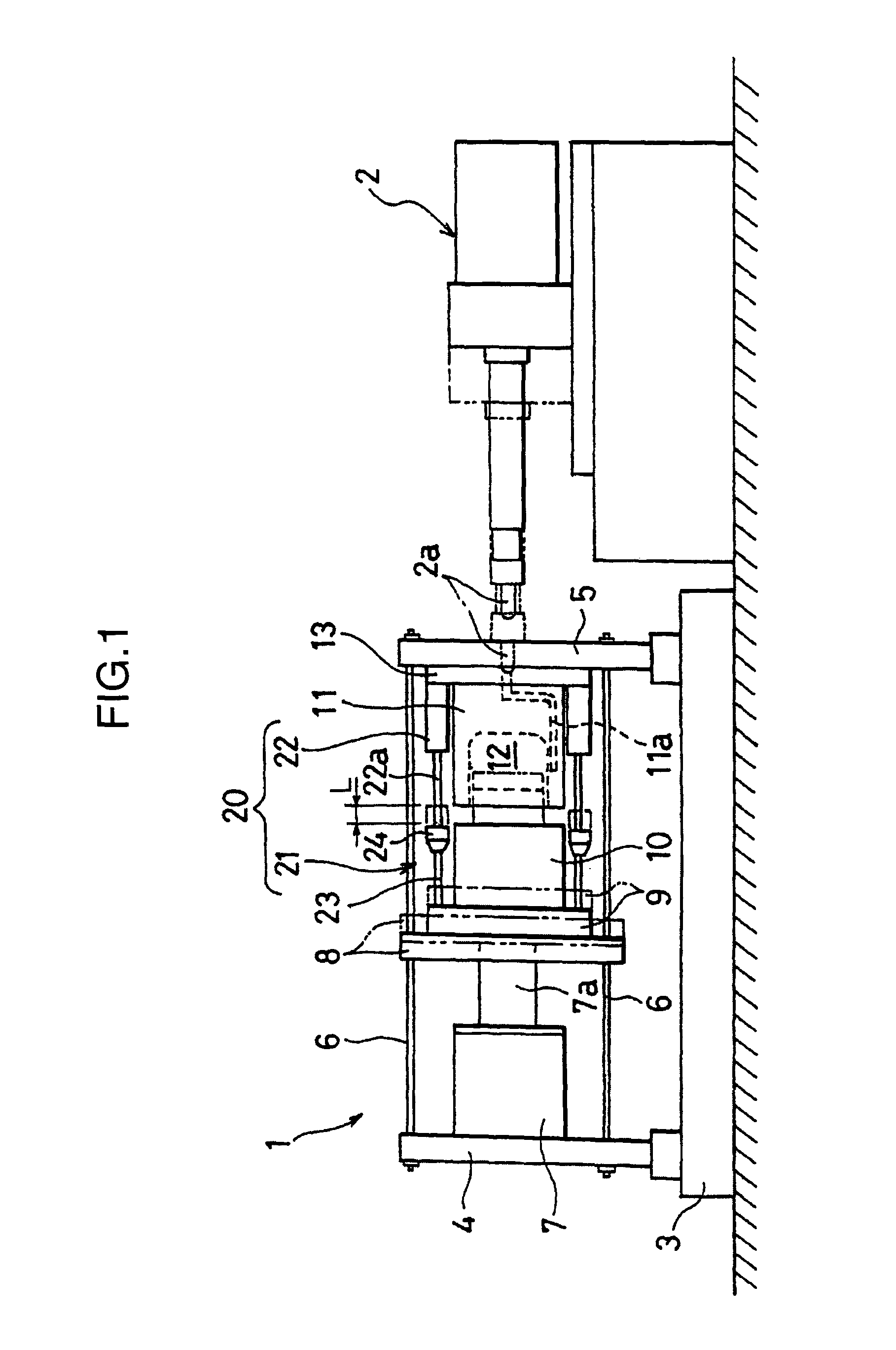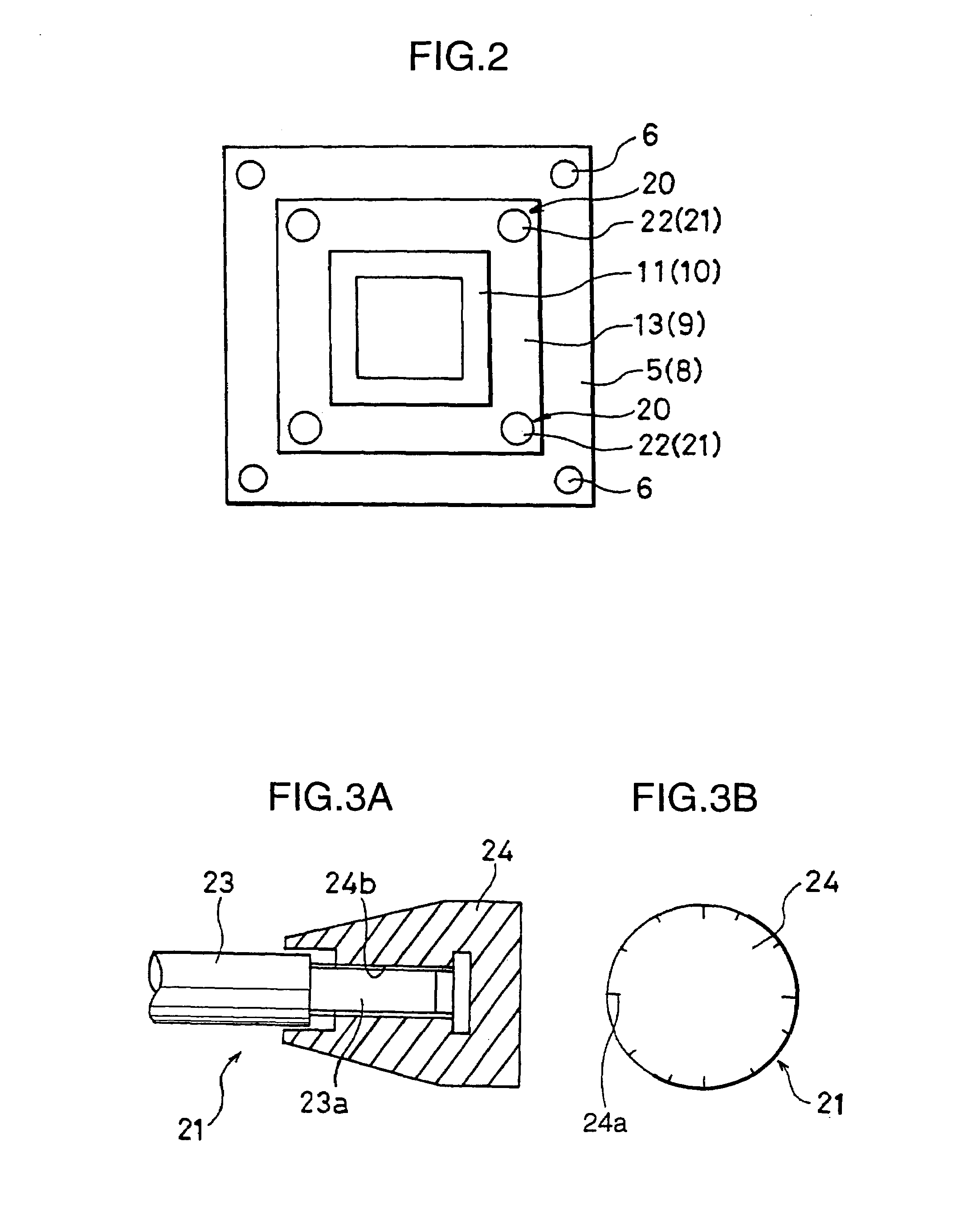Injection and compression molding with parallelism mechanism
- Summary
- Abstract
- Description
- Claims
- Application Information
AI Technical Summary
Benefits of technology
Problems solved by technology
Method used
Image
Examples
example 1
[0182]The polycarbonate resin pellets PC-1 were dried at 120° C. for 5 hours by a hot air dryer, and injection molding was performed by an injection molding apparatus J1300E-C5 produced by Japan Steel Works, Ltd. with cylinder diameter: 110 mm and clamping force: 12,700 kN (produced according to the specifications in which the hydraulic circuit and the control system were so modified as to enable compression molding). The parallelism retaining mechanism 20 was mounted at four corners of the mold attaching plates as shown in FIG. 1. Micrometers were attached as the head members 24. Parallelism as preparatory operation was implemented to secure parallelism between the molds when the molds were set to a specified intermediate clamped state. Then, injection compression-molding was carried out to produce a molded article having the dimensions of about one-half of a glazing member for automotive vehicle as shown in FIG. 7 (projection area of article: about 2,100 cm2, thickness of article:...
example 2
[0189]The polycarbonate alloy resin pellets PC-2 were dried at 120° C. for 5 hours by a hot air dryer, and a molded article having dimensions (projection area of article: about 2,100 cm2, thickness of article: about 3 mm) having dimensions of about one-half of a rear door for automotive vehicle as shown in FIGS. 8A through 8C was produced by using the same apparatus as in Example 1 (in a state that the parallelism retaining mechanisms were activated).
[0190]FIGS. 8A through 8C are diagrams showing the molded article produced in Example 2. FIG. 8A is a front view of the molded article. FIG. 8A shows the front view of the molded article that is projected against the platen plane at the time of molding. Accordingly, the projection area corresponds to the maximal projection area of the molded article.
[0191]It should be appreciated that a gate is located at a lower part of the molded article. FIG. 8B is a sectional view taken along the line C—C in FIG. 8A, wherein the line C—C is aligned ...
example 3
[0205]The polycarbonate resin pellets PC-1 were dried at 120° C. for 5 hours by a hot air dryer, and a Fresnel lens having a convex part of about 25 μm in height (projection area of article: about 1,100 cm2, thickness of article: about 0.7 mm) was produced by using the same apparatus as in Example 1 (in a state that the parallelism retaining mechanisms were activated).
[0206]Cylinder temperature: 310° C., and hot runner temperature: 320° C. were set as the molding conditions. Further, the following high-speed heating-and-cooling molding was carried out while setting the base temperature of the mold at 100° C.
[0207]According to the high-speed heating-and-cooling molding, resin filling was terminated under the rapid heating conditions where the highest temperature of the cavity of the molds reaches 200° C. with use of a heater which follows a cooling process where the molds were rapidly cooled by passing a refrigerant of about 10° C. with use of a chiller unit. The resin filling time w...
PUM
| Property | Measurement | Unit |
|---|---|---|
| Percent by mass | aaaaa | aaaaa |
| Fraction | aaaaa | aaaaa |
| Fraction | aaaaa | aaaaa |
Abstract
Description
Claims
Application Information
 Login to View More
Login to View More - R&D
- Intellectual Property
- Life Sciences
- Materials
- Tech Scout
- Unparalleled Data Quality
- Higher Quality Content
- 60% Fewer Hallucinations
Browse by: Latest US Patents, China's latest patents, Technical Efficacy Thesaurus, Application Domain, Technology Topic, Popular Technical Reports.
© 2025 PatSnap. All rights reserved.Legal|Privacy policy|Modern Slavery Act Transparency Statement|Sitemap|About US| Contact US: help@patsnap.com



